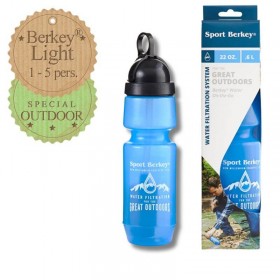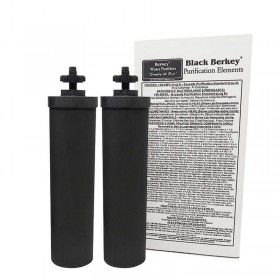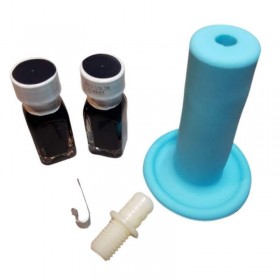Check that your Berkey® is correctly assembled using the red dye test
Black Berkey Primer™ is a manual pump that allows for easy priming of Black Berkey™ filter elements without the need for faucet pressure or when there is limited space under the faucet.
Priming the Black Berkey® purification elements is essential to expel air and saturate the filters with water before use.
The Primer™ pump also allows you to purge the Black Berkey® purification elements with air to clean the filter pores if necessary and to dry the filters for long-term storage (see information on storing Black Berkey® filters for details).
The Primer pump therefore allows you to:
1- Eliminate debris that can accumulate in the filter pores during use,
2- Reduce the time and effort required to dry the filters before storage,
3- Facilitate the priming of the elements when water pressure is not accessible or when space under the faucet is limited, such as with a small sink.
4- Black Berkey® filters should never be primed with contaminated water. This is the case, for example, if you only have access to reclaimed water such as rainwater, borehole water, well water, etc. You must prime them with the Black Berkey® Primer pump. It is an essential tool in these conditions.
The Black Berkey Primer™ is specifically designed for use with Black Berkey® purification elements.
Find the instructions for using the Black Berkey Primer™. To complement this information, you can watch a video on using the Black Berkey Primer™.
Black Berkey® water filters are so effective that they can remove red food coloring from water. This is a foolproof way to test your system and ensure it is functioning correctly.
The purpose of this test is to confirm that the system has been assembled correctly and that there are no internal leaks in your system. We recommend performing this test after the initial assembly of our systems, after removing or replacing Black Berkey® elements, or during the first use after drying and storing the elements for an extended period.
The dye test is designed only for Black Berkey® purification elements. It should not be performed for the Sport Berkey® bottle or the PF-2 filters.
The food coloring must be RED, LIQUID and ARTIFICIAL
. Red food coloring (unlike other colors) does not contain minerals, so your filter will treat it as a contaminant and filter it out.
You can find this food coloring in small bottles at specialty or arts and crafts stores. You must use a liquid coloring, not gel, and check its composition: it should not contain glucose, E330, or thickeners. The coloring should not be E120 Carmine (cochineal) or E162 Betanin (beetroot).
Therefore, ensure that the food coloring used contains either E122 (carmoisine), E123 (amaranth), E124 (Ponceau), E127 (Erythrosine), E129 (Allura Red), or E180 (Rubine).
Be aware that some red colorings also contain E102 (Tartrazine yellow) in their composition, which is also not suitable for the test.
The red food coloring test should be performed after priming your Black Berkey® purification elements and WITHOUT THE PF-2 FILTERS™.
TO PERFORM THE TEST:
- Start by removing all Berkey PF-2™ filters (if installed). If they remain in place, the warranty on these filters will no longer be valid.
- Take only the upper chamber (with the Black Berkey® elements installed) and place it on containers (glasses, cups, vases...) of similar size so that there is a container under each filter. This will isolate any defective or leaking filters.
- In a separate container filled with water, add the food coloring according to the proportions indicated below. Mix well. DO NOT pour the coloring directly into the tank.
Prepare a mixture with the volume indicated below:
COLORING DOSAGE for standard European brands
3-5 drops of red food coloring per 4 liters of water.
MCCORMICK COLORING DOSAGE recommended by Berkey®
10 drops per 4 liters of water, as follows:
- Travel Berkey® - 4 liters of water, 10 drops
- Big Berkey® - 8 liters, 20 drops
- Royal Berkey® - 8 liters, 20 drops
- Imperial Berkey® - 8 liters, 20 drops
- Crown Berkey® - 8 liters, 20 drops
It is not necessary to completely fill the upper chamber for larger models, as long as the filters are fully submerged.
- Let the water flow into the containers.
If no red food coloring appears in any of your containers, your purification system is working correctly.
If the water in any of the containers is red or has a pink tint, the filter in question is either defective, nearing the end of its life, or not sealed properly, allowing water to flow between the seal and the tank.
IF YOU NOTICE COLORING IN ANY OF THE CONTAINERS, PLEASE CHECK THE FOLLOWING:
- Are the nuts properly tightened? Do not use tools to tighten them. They should be hand-tightened for a perfect fit. Over-tightening the nuts could deform the threads, preventing a proper seal.
- Have you used "red food coloring"? Red food coloring is the only type recommended for this test.
- Is the washer on the stem properly placed inside the upper chamber with the nut fixed underneath? If the washer is outside the chamber with the nut, you will not have a proper seal, causing your system to malfunction. Place the washer inside the upper chamber and retest.
- Are the blocking plugs properly sealing the unused holes (without filtering elements)? Are the plugs installed and tightened with a washer on each side? If the plugs are leaking, the test will fail. Tighten the plugs more firmly and retest.
- If you are testing an element that has already failed, rinse and re-prime it. Retest.
If, despite all these precautions, a filter fails the dye test, please contact customer service.
When performing the test a second time, consider taking a video of your actions (mixing the dye, filling the upper tank, filtering into separate containers). Proof is required in case of a positive test and a claim.



















